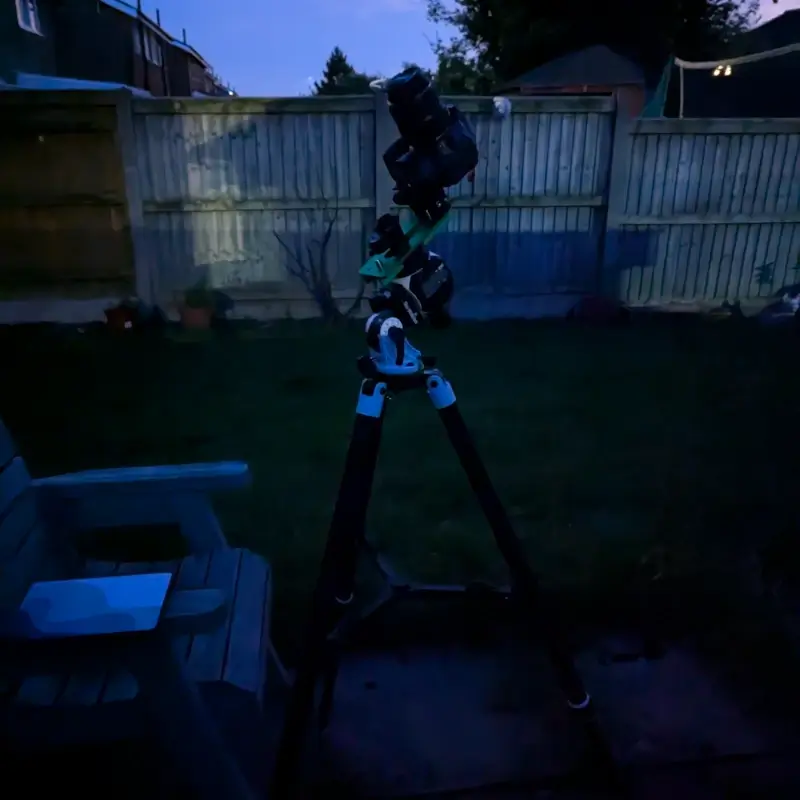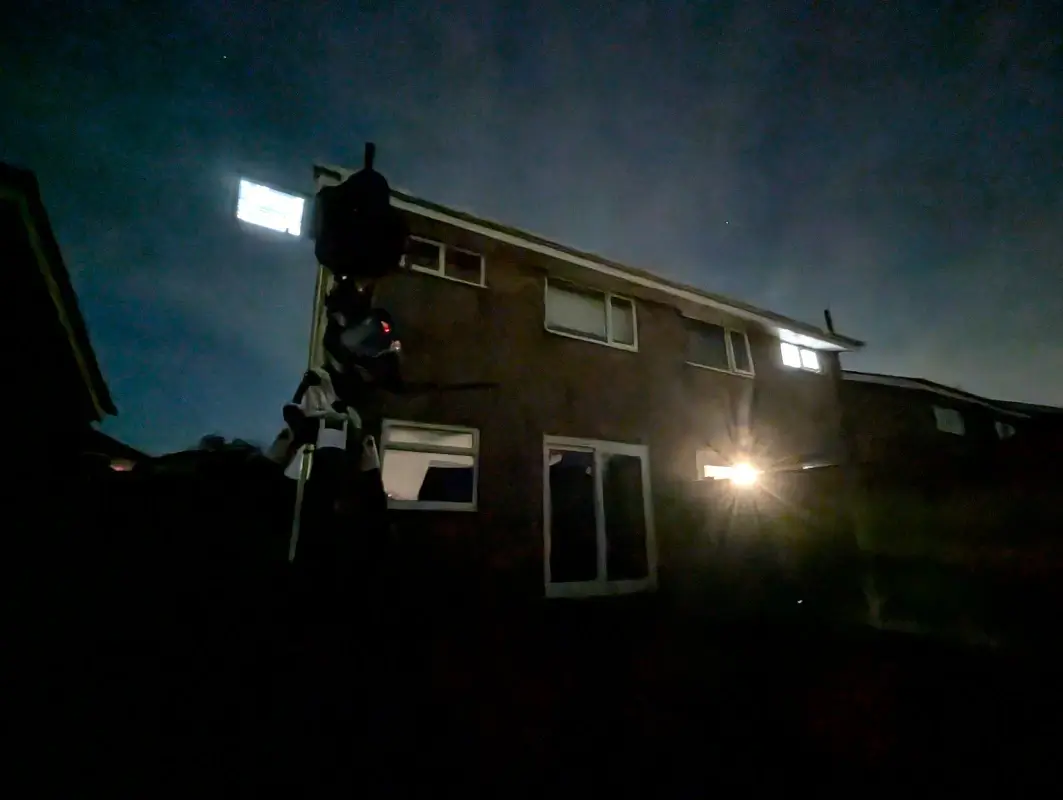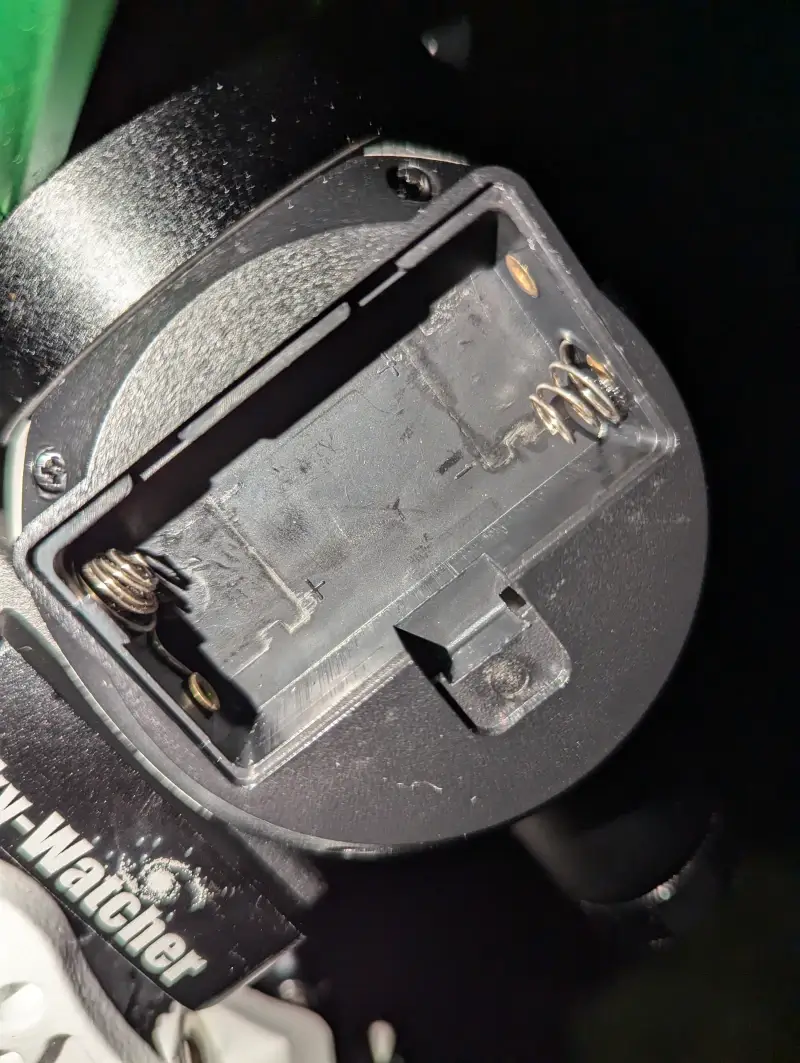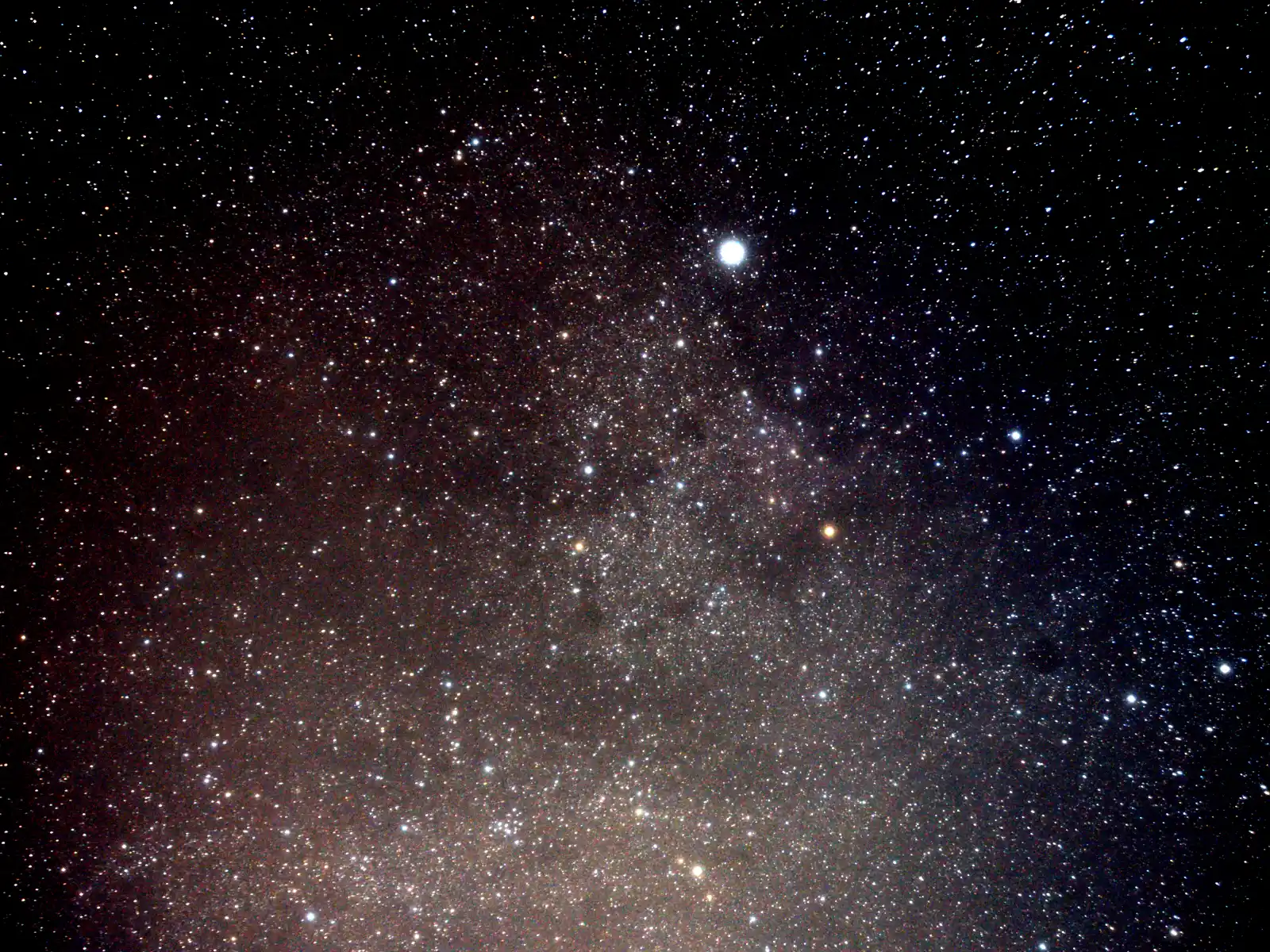This log will not have an accompanying observation report, as the final image wasn’t dissimilar to the previous observation report for NGC 7000.
23:10 – I’ve just set up my new star tracker and tripod and I’m getting ready to try and align it with Polaris. This is my first time using the Star Adventurer Mini (SAM), and it’s also my first time using any type of tracking system.
There are some wispy clouds in front of Polaris, at the moment so I can’t actually see it, but hopefully, they should clear in a moment and then I can start the alignment.
23:20 – I’m now aligned with Polaris and now I’m going to direct the camera towards the North American Nebula again. I’m getting pretty good at finding this target now, as this is the fourth shoot I’ve done with this as my focus.
23:38 – I’ve had to perform one or two re-adjustments to the alignment as I’ve knocked the tripod or accidentally shifted it while handling the camera. While my gear feels very solid in this setup, I still need to take care not to be so heavy-handed.
I’ve taken a few test shots to see how the images turn out. The great thing about the Sky Adventurer Mini is that it allows you to control the camera shutter via a cable. By then setting the camera’s exposure time to ‘bulb’, it’ll take a picture for as long as the shutter button is held. The downside to that great functionality is that my cable hasn’t arrived yet. As such, I’m limited to the camera’s 30-second maximum exposure time for now.
23:44 – I’ve got the North American nebula in my view. I’m going to stick with ISO 400, 30-second exposures, f/5.6. There’s a lot of clouds here. I’m expecting a lot of these frames to be partially obstructed, or to at least have some hazing from the thin clouds blocking the brighter stars.
23:50 – I hate moths. Go away.
23:51 – Looking online, I can see various people have success running 800 ISO for 120 seconds. While I’m thinking maybe 800 ISO is probably the right choice, I’m going to stick to my initial decision of 400 ISO for this shoot. Next time around, I’ll definitely go with 800 to try to pick up on some extra details. Tonight is only a trial, it doesn’t have to be perfect.
00:00 – A big source of frustration for me is that my neighbours have absolutely no interest in their electricity bills, the environment, or my best interests. What I’m trying to say is that they have their kitchen light on all night, which seems to reach every corner of my garden in a humorously intrusive fashion, considering my niche hobby. Additionally, they also have a motion-activated flood light in their garden. Pair that with our very active bat population in the area, and suddenly it’s turning on at least every 2 minutes. Rather than ask my neighbour to turn their lights off, I’m going with the passive-aggressive approach of complaining online and pouting.
00:05 – The clouds seem to be mostly behaving. There are the faint, whispy ones floating around though. Because of the lights from my neighbour, my eyes are really not adjusting to the dark. While I can see the brighter stars up above, it’s hard to identify the clouds… On the bright side (pun intended), I can see around my garden perfectly fine.
By capturing the same target I’ve done a few times recently, I’m able to compare myself to a baseline to see how my images are (hopefully) improving as a result of developing my knowledge and equipment. Additionally, the North American Nebula is almost directly above me, meaning it currently rests in the best place for minimising the effect of the light pollution dome.
00:10 – My takeaways from the last session included:
- Not letting the mount droop.
- Not accidentally changing the camera settings.
- Regularly check for dew build-up on the lens.
So far, I’m three-for-three. The new mount is excellent, I’ve been careful with the camera, and I’ve checked the lens every 10 minutes with no sign of any moisture so far.
00:13 – There’s a parade of bigger clouds coming through now. They seem to be coming quite fast and, while thick, aren’t super large. I’m going to take a break from capturing pictures for the next 5 minutes while they pass and I’ll review the images I’ve taken so far.
00:17 – It looks like the larger clouds have rolled off, and we’re back to the regularly scheduled whisps.
00:29 – My neighbour turned their kitchen light off! Both myself and the Earth thank you, neighbour. I’m sure the energy provider didn’t mind the extra usage on their tariff though.
00:32 – I’m now starting to reach the end of my endurance. While I’m certainly not comfortable enough to fall asleep out here, I’m yawning a lot and all I can think about is my nice, warm bed. Frustratingly, the sky is getting clearer by the second. I feel like persevering through the next 30 minutes will be worth it. The weather apps and my current view both agree that this is the one period of almost 0% cloud coverage. Since my neighbours have also done me the courtesy of going to bed, I think it’s important I push through this last sprint. I’m pretty certain that most of the pictures I’ve taken up to this point are at least partially obstructed by clouds anyway, so getting as many clean, quality exposures as possible is essential if I want an improvement on my previous attempts final image.
I’ve decided that I’ll keep taking pictures until at least 00:50. At that point I’ll start taking my dark frames while packing up everything else.
00:40 – The sky is still clear and I’m still taking pictures. I’m considering the differences between this shoot and my previous one, and I’m rather unsure as to what results to expect. For example, what difference in quality is there between a single 30-second exposure vs 5 x 6-second exposures? The reason I’m curious is that I found I had approximately 16 minutes of stackable image exposures from my last shoot. I wonder if I’ll actually have more this time or not (once I prune the obstructed images). Honestly, with the cloud issue from earlier, it might not total much extra time. This begs the question then: Do single, longer exposures provide any benefit compared to a stacked image of identical exposure time? I’d love to test this by taking a few shorter exposures and stacking them, but I don’t want to waste any of my shooting time tonight. I’ll make a note to test this myself when the nights are a bit longer and I don’t have to wait until midnight to take pictures.
00:50 – I’ve had a disaster, but I don’t know what’s happened! This is my first time using the Star Adventurer Mini and it was last reporting 2.48v power, meaning it had plenty of juice left. I decided to check my most recent exposure, and I saw star trails. I figured that the mount perhaps ran out of power. When I took the panel off the side, I could smell alkaline. I took my batteries out and I found that one of the negative terminals was squashed down. I can’t see any signs of damage to the batteries, but the mount is not powering on at all. I’ve taken some pictures, but I’m guessing that this, my first outing with SAM, is also my last.
00:55 – I’m going to take some dark frames while I’m out here as I need to do this while the temperature of the camera matches the temperature for when the light frames were taken. In the morning I’m going to have to see what can be done with the Star Adventurer Mini by contacting the retailer. I don’t think I did anything wrong; I used high-quality batteries, read the manual cover-to-cover, and had a very successful session with it running for over an hour. I suppose this is what warranties and return periods are for, but it’s really upsetting to have this happen on my first session with a tracker.
The next day – I felt it was worth adding a resolution to the issue with my Star Adventurer Mini. It looks like one of the springs on a negative battery terminal is set in a sunken position. I’m not certain as to why, but my theory is that something to do with the temperature has influenced the way the metal has retained the shape, instead of springing back. I wonder if this is a by-product of the way this unit has been stored over the years while waiting to sell. Again, this is all speculation. Fortunately, it seems like swapping this with the retailer shouldn’t be a problem. It’ll just mean I might have to wait a week or two to get the replacement back. When I get my replacement, I’m going to use an external power supply only. No more AAs.
Camera: Nikon D5600
ISO-Speed: 400
F-stop: f/5.6
Exposure time: 42.5 minutes (30*85)
Description: A field of stars with an orange cloud-like shape in the middle, NGC 7000 (the North American Nebula).




0 Comments